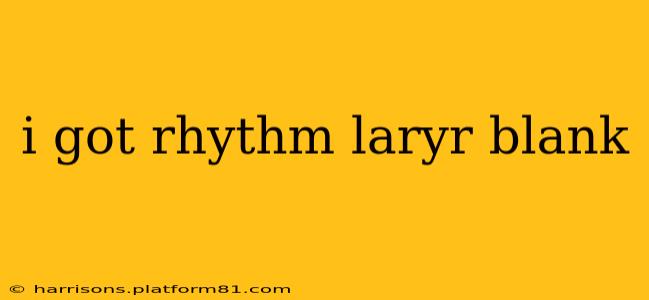I Got Rhythm: Filling in the Blanks of a Jazz Standard
"I Got Rhythm" is more than just a song; it's a cornerstone of jazz harmony and improvisation. Its simple, memorable melody and incredibly versatile chord changes have made it a springboard for countless variations and reinterpretations throughout jazz history. But what if you're trying to learn the lyrics and find yourself facing a blank? Let's fill in those blanks and explore the song's enduring appeal.
The most commonly known lyrics are those written by Dorothy Fields, but it's important to remember that the song's enduring power lies in its harmonic structure, not just its lyrics. Many jazz musicians have improvised lyrics or used the melody as a vehicle for instrumental expression.
What are the original lyrics to I Got Rhythm?
The original lyrics by Dorothy Fields are quite straightforward, painting a picture of carefree joy and confidence. They focus on the feeling of rhythm itself, describing its effect on the singer and their happiness. While not overly complex, they're effective in conveying a sense of upbeat optimism. You can easily find the complete original lyrics online through a quick search. They're widely available and are essential to understanding the song's initial intent.
What are some common variations of the lyrics?
Because "I Got Rhythm" is such a popular song standard, countless musicians have played around with the lyrics. Some variations might be quite minor, perhaps changing a word or two here and there to fit their own personal style or interpretation. Others might be complete rewrites, using the melody as a framework for entirely new poetic content. These variations often reflect the individual musician’s unique approach and musical background, making each performance special.
How can I learn all the verses of I Got Rhythm?
There's no single definitive number of verses for "I Got Rhythm." The original version has a limited number of verses, easily learned and memorized. However, the song's nature lends itself to endless improvisation, both musically and lyrically. Many performers add or improvise verses, making the song a true canvas for creative expression. The best way to learn is to find recordings of well-known versions, analyze the lyrics, and practice singing along. This will not only help you learn the original but also expose you to the variety of lyrical approaches possible.
What are the chords to I Got Rhythm?
The true magic of "I Got Rhythm" lies in its remarkably adaptable chord progression, often referred to as the "Rhythm Changes." This harmonic structure is used as a foundation for countless jazz standards and improvisations. Understanding these chords is key to grasping the song's enduring importance in jazz music history. You can find many resources online providing chord charts – look for a chart that includes both standard notation and chord symbols. This will allow you to play along on an instrument, or use the chart to inform your own vocal interpretation.
Why is I Got Rhythm so important in Jazz music?
"I Got Rhythm" holds immense significance in jazz for several reasons. Firstly, its simple yet effective melody and chord progression make it a perfect vehicle for improvisation. Secondly, its harmonic structure has been borrowed and re-harmonized countless times, becoming the blueprint for a myriad of other jazz standards. Finally, the song's optimistic tone and inherent swing feel resonate deeply with the spirit of jazz music. Its influence continues to inspire musicians even today, cementing its status as a jazz cornerstone.
By exploring the original lyrics, common variations, and the core harmonic structure, one can fully appreciate the enduring legacy of "I Got Rhythm" – a song that continues to inspire and challenge musicians across generations. Learning the lyrics is just the starting point for understanding this essential piece of jazz history.
